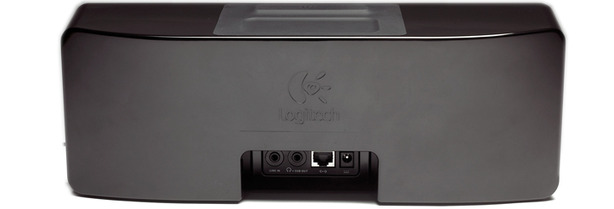Squeezebox Hardware
Once you’ve got the software up and running and it’s scanned your hard disk, you need to configure the Boom itself. Early reviews complained it was fussy to set up, but we found it extremely easy. You can plug in an Ethernet cable, or just leave it to use 802.11g WiFi networking; once you’ve put in your password, ‘set up’ is largely just a case of hitting the left button to go onwards and waiting for the Boom to acquire an IP address and find your copy of Squeezecenter. That done, you’re ready to rock and roll.Using the D-pad on the remote or the large dial on the Squeezebox, you scroll through menu options; streamed music is sorted by the usual selection of metadata - Artist, Album, Year, Genre – and the Boom can also pick up playlists from the host machine, and search in your library. That said, the monochrome display doesn’t make moving through your music collection easy.
Although it’s relatively large, only one line is used to display the current item you’re looking at, so it can be hard to know where in a list of songs or artists you are. Even compared to an iPod Touch its layout makes it seems small and cramped. I’ve got music from over 670 artists in my library, and using the Boom I had a horrible feeling I was going to spend all my time listening to Abba and Arcade Fire because it took so long to scroll through the list. Smarter sorting – and preparing playlists – definitely helps this issue, though.

The Boom can shake a good sized room - it's fairly loud for its size
As well as streaming music from your PC, the boom can also play streaming audio from the web. We’ve already mentioned the way it links into services such as Last.fm, but it also plays internet radio. A huge number of radio stations stream their output to the web, and exploring these is one of the most fun parts of using the Boom. As well as sorting stations by music and genre, you can also browse by location, so if you want to see what the hip kids of the Vatican City are listening to, or replicate being in the back of a Taipei taxi, it’s very easy.
The boom features two 30w speakers. At high volume (above 80%), the audio does start to distort, but at 50% it’s loud enough to fill a big room such as a kitchen. You’re certainly not getting £175 worth of pure audio quality – the Boom doesn’t compare to Logitech’s fantastic Z-5500 speakers for instance – but it’s certainly not bad, especially considering its compact size. The bass is surprisingly powerful and punchy - but it doesn't have a huge range. It's far better at thunking, thudding rock drums than more subtle bass guitar sounds or processed beats.

The Boom can connect to your network via Ethernet or WiFi
As a result of this muddiness, the sound does lose some detail and dynamism, and of course, as the speakers are close together, you don't get a huge expansive sound stage. That said, these are audiophile-level complaints, and it's important to remember the Boom isn't a HiFi. For its size and its targeted use - in a room such as a kitchen or study - it offers sound with plenty of presence and a decent amount of detail.
Overall then, the Squeezebox Boom is easy to setup, and is backed by powerful, flexible software that’s compatible with a huge range of files and services. The hardware is slightly less impressive – the display in particular is small and cramped, and for the price, the speakers aren’t exceptional. However, as a total package, it’s hard to find a significant problem with the Boom, and as the price comes down, it’s looking increasingly like the perfect general household MP3 stereo.
- Performance
- x
- x
- x
- x
- x
- x
- x
- x
- -
- -
- 8/10
- Features
- x
- x
- x
- x
- x
- x
- x
- x
- x
- -
- 9/10
- Value
- x
- x
- x
- x
- x
- x
- x
- -
- -
- -
- 7/10
- Overall
- x
- x
- x
- x
- x
- x
- x
- x
- -
- -
- 8/10

Logitech Squeezebox Boom

MSI MPG Velox 100R Chassis Review
October 14 2021 | 15:04









Want to comment? Please log in.